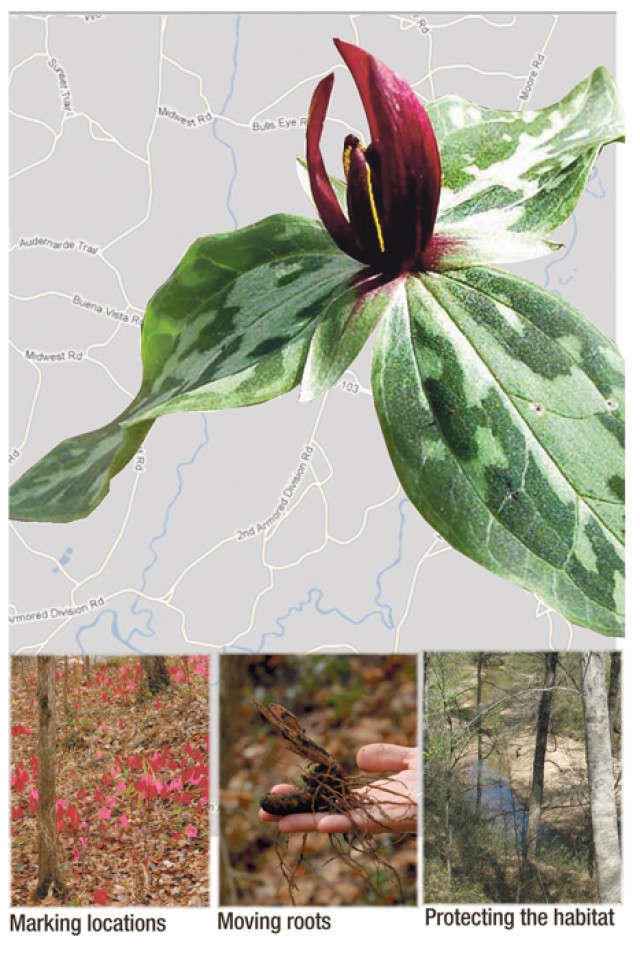Relocating the relict trillium
FORT BENNING, Ga. - Post conservation officials began digging up hundreds of relict trillium roots along Fort Benning's northern edge Tuesday in preparation for a huge transfer of the rare plant to safer ground.
The preservation move is necessary to allow for construction of a bridge over Randall Creek, which will provide access to new training ranges that support the Maneuver Center of Excellence and Base Realignment and Closure initiatives, said Mark Thornton, endangered species biologist for the Conservation Branch of Fort Benning's Environmental Management Division. The relocation is expected to take about a week and will involve about 1,300 adult plants.
"The plants will be moved to three different locations - one on Fort Benning, one site protected by the Georgia Department of Natural Resources and a protected private preserve near the installation," he said. "We do not give exact locations due to the threat of possible illegal harvesting."
Fort Benning spends about $20,000 annually on management and protection of the relict trillium, Thornton said. The relocation project will push that figure to $50,000 this fiscal year.
Relict trillium, also known as Trillium reliquum Freeman, is a small flowering plant that only surfaces between March and May. It's dormant most of the year. The U.S. Fish and Wildlife Service has listed it as endangered since April 1988.
Thornton said there are two known populations in Alabama, 14 in Georgia and four in South Carolina.
"When a species is limited to this small of an area geographically, it becomes susceptible to extinction through natural disasters and extremes in regional weather patterns such as drought," he said.
He said all the known Trillium reliquum populations are threatened by several human activities, the most significant being the loss or alteration of their habitat stemming from residential development.
"Most populations are adjacent to rapidly expanding urban areas, and the direct impacts of construction activities associated with an expanding population are significant," he said.
Populations are stable on Fort Benning, where five are known to occur - each containing more than 1,000 individual plants, he said. There are at least 10,000 plants within the entire Randall Creek North cluster.
Thornton said Fort Benning has routed much of the BRAC and MCOE construction away from relict trillium areas to avoid degrading its habitat. The Randall Creek bridge project was moved from its original site to lessen the impact, he said.
Conservation officials prepped for the dig by placing red flags in the area last spring to mark the locations of adult relict trillium plants.
Michele Elmore, an ecologist with the Conservation Branch, said most relocations work best when the plants are dormant, because the energy is being stored in the root mass for growth.
"They're easier to handle, and it's actually less stress on the plant," she said. "If you get it too late, it won't acclimate to its new site as well. You generally have better success for survival if you move it before it blooms.
"Looks like we got here at just the right time. Another week, and we might've been too late."
Thornton said invasive species pose the greatest danger to relict trillium populations on the installation. In particular, feral swine are attracted to their habitat.
"When swine move into an area, they will often root up an area while feeding, leaving it looking like a plowed field," he said. "This type of activity could destroy large areas - if not entire populations - if feral swine are allowed to get out of control in these areas."
Three of Fort Benning's five populations have been fenced to keep feral swine from rooting up the area, he said. Officials plan to fence off a fourth later this year.
Aggressive weedy species such as Japanese honeysuckle and privet are other potential threats to relict trillium through competition.
The Environmental Management Division has the task of overseeing the landscape for training activities while maintaining the environment in a manner that will support a diverse wildlife community, Thornton said.
"Fort Benning's management for relict trillium takes a proactive approach and is geared toward improving habitat in areas that are suitable for trillium and in areas that currently have trillium," he said. "The goal is not only to preserve what Fort Benning currently has but also to improve its current status."
FAST FACTS ON THE RELICT TRILLIUM
WHAT IS IT' A spring flowering, tuberous, rhizomed perennial that dies back to the rhizome after the fruit matures. It has a stalkless flower in the coiled center of three strongly mottled leaves. The leaves feature five shades of color - from green through blue-green to silver, with a strong central silvery streak on the upper surface. The flowers are much shorter than the leaves and emit an unpleasant, fetid odor.
WHERE IS IT FOUND' In limited portions of Alabama, Georgia and South Carolina.
WHERE DOES IT GROW' The species occurs primarily in undisturbed, moist hardwood forests. On Fort Benning, it's usually associated with large drainage areas.
HOW LONG HAS IT BEEN ENDANGERED' Since April 1988.
Source: Fort Benning Conservation Branch


Social Sharing